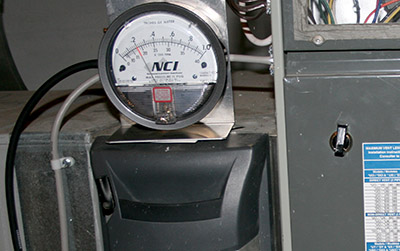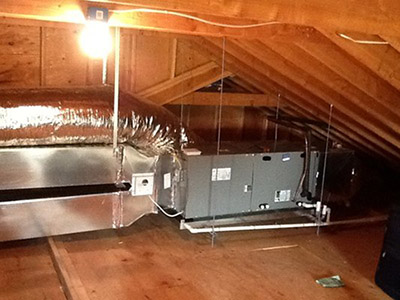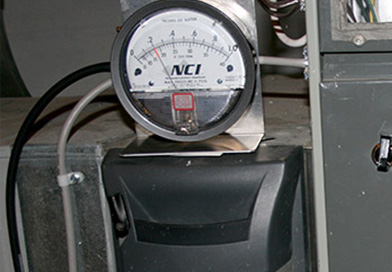There’s lots of discussion being kicked around these days about residential ducts being substantially undersized. Here’s a two-minute test that can check the size and performance of your duct system. The instruments are inexpensive and it takes less than 10 minutes to learn to do.
Tons of Air
Static pressure is a measurement of how hard a fan has to work to move airflow through a duct system. Contrary to what we might imagine, air is really heavy. One pound of air at sea level is the size of a cube measuring 2.5 square feet on each side.’ At 2000 cubic feet per minute (cfm), a five-ton fan pushes and pulls 9,000 pounds of air through its duct system in one hour of operation. That’s surprisingly close to five tons of air per hour, isn’t it?
Here at NCI we receive live system performance test data from our members every day. We study this data like mad men to unlock the mysteries of why most systems perform so poorly.
As we looked at systems earning high operating efficiency scores (above 90%), we have discovered an interesting pattern: We found that well-operating systems nearly always have duct-system pressure drops of less than 40% of fan-rated pressure. For example: If a fan is rated at .50′, take .50’x 40% to find the ideal duct system pressure drop of .20?.
The Duct Pressure Budget
So, in order to quickly determine the duct pressure budget for any system, take the system fan rated pressure, (simply read it from the equipment nameplate) and multiply it by 40%. Here’s a quick reference table to save you from doing the math.

So, in order to quickly verify if your system duct size is adequate and that the installation quality is up to snuff, measure the pressure drop of the duct system in the field under maximum airflow conditions. If the duct pressure drop is at or below the duct system pressure budget, the duct system passes the pressure test. If the duct pressure drop is above the pressure budget, your customers need you to fix it.
A Comment on Static Pressure
 When testing, understand that measuring duct static pressure is more than just the ducts. The duct system consists of plenums, trunk duct, fittings, dampers, branch ducts, twig ducts, boots, cans, and grilles. So remember this: the supply duct system handles air from the discharge of the equipment to the supply registers, and into the room. The return duct system handles air from the return grille to the filter installed at the inlet of the equipment.
When testing, understand that measuring duct static pressure is more than just the ducts. The duct system consists of plenums, trunk duct, fittings, dampers, branch ducts, twig ducts, boots, cans, and grilles. So remember this: the supply duct system handles air from the discharge of the equipment to the supply registers, and into the room. The return duct system handles air from the return grille to the filter installed at the inlet of the equipment.
Manufacturers rate a fan at a certain total external static pressure. In tech terms, they are saying, ‘Here’s a fan that will move the required airflow so this system actually will work in the field. However IF the components you add to my equipment exceed the rated total external static pressure, it won’t work worth beans.’ Maybe they would say it more formally, but you get the idea.
How to Measure Duct System Pressure Drop
You’ll need a manometer and the appropriate accessories. Drill a 3/8′ test hole in the supply plenum and one in the return plenum. Zero your manometer if it is digital, or level your manometer if it is analog.
Connect the pressure hose to the positive pressure port of the manometer. Insert the static pressure tip into the test hole in the supply plenum. Read and record the pressure displayed on the manometer. This is the supply duct system pressure drop. Pretty simple, right?
Compare the measured supply duct system pressure drop to the appropriate supply duct pressure budget listed in the table above, compared to the rated fan pressure.
Repeat the steps for the return duct, except connect the pressure tubing to the negative pressure port of your manometer. Compare the return duct system pressure drop to the table above. If there is a return air filter grille, you’ll have to deduct the pressure drop of the filter.
Remember, this is just one in a series of airflow diagnostic tests. If the pressure is nice and low and an inspection reveals one of the ducts is disconnected, this duct system passed the pressure budget test, but fails the next test which is to measure the actual CFM of supply and return duct leakage, but that’s another article.
As Dominick Guarino always says, ‘If you don’t test, you’re just guessing.’
What’s Next?
 Odds are that you’re duct pressures will exceed the budgets listed above. Recent studies show the typical residential HVAC system static pressure is over .80?. That’s a pretty serious problem considering a vast majority of fans are rated at .50′, or equal to human blood pressure of 210 over 140, compared to 120 over 80. Both the human and the HVAC system need to be checked into the hospital immediately.
Odds are that you’re duct pressures will exceed the budgets listed above. Recent studies show the typical residential HVAC system static pressure is over .80?. That’s a pretty serious problem considering a vast majority of fans are rated at .50′, or equal to human blood pressure of 210 over 140, compared to 120 over 80. Both the human and the HVAC system need to be checked into the hospital immediately.
The obvious answers are bigger ducts and better duct installation practices. Knowing where to start follows an inspection of the duct system, if it’s accessible. The next step is to continue down the measurement path and actually measure the airflow delivery of the fan or the airflow into and out of the grilles and registers.
One thing for sure is that when it comes to performance, if your customers want it, there is always a way to improve any duct system. A small amount of work can yield huge improvements when you follow good system diagnostics.
As we move forward as an industry, it’s becoming ‘more obvious that the solutions to the comfort and energy issues we face will be found in the duct system. The choice is becoming clear. Do we kick up equipment energy ratings and net out a 3% increase in real efficiency or do we repair system performance and increase real efficiency by 25% or more.













Recent Comments